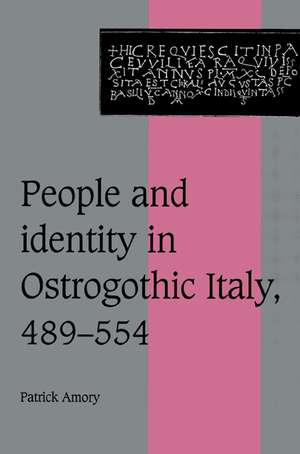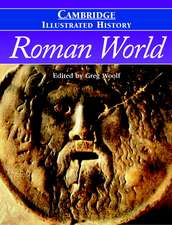People and Identity in Ostrogothic Italy, 489–554: Cambridge Studies in Medieval Life and Thought: Fourth Series, cartea 33
Autor Patrick Amoryen Limba Engleză Paperback – 15 oct 2003
| Toate formatele și edițiile | Preț | Express |
|---|---|---|
| Paperback (1) | 352.47 lei 6-8 săpt. | |
| Cambridge University Press – 15 oct 2003 | 352.47 lei 6-8 săpt. | |
| Hardback (1) | 951.52 lei 6-8 săpt. | |
| Cambridge University Press – 12 iun 1997 | 951.52 lei 6-8 săpt. |
Din seria Cambridge Studies in Medieval Life and Thought: Fourth Series
-
 Preț: 202.55 lei
Preț: 202.55 lei -
 Preț: 285.93 lei
Preț: 285.93 lei -
 Preț: 178.26 lei
Preț: 178.26 lei -
 Preț: 193.42 lei
Preț: 193.42 lei - 9%
 Preț: 593.04 lei
Preț: 593.04 lei -
 Preț: 310.71 lei
Preț: 310.71 lei -
 Preț: 239.98 lei
Preț: 239.98 lei -
 Preț: 282.10 lei
Preț: 282.10 lei -
 Preț: 321.31 lei
Preț: 321.31 lei -
 Preț: 266.37 lei
Preț: 266.37 lei - 11%
 Preț: 639.92 lei
Preț: 639.92 lei -
 Preț: 314.61 lei
Preț: 314.61 lei -
 Preț: 348.65 lei
Preț: 348.65 lei -
 Preț: 284.39 lei
Preț: 284.39 lei -
 Preț: 329.64 lei
Preț: 329.64 lei -
 Preț: 322.29 lei
Preț: 322.29 lei -
 Preț: 320.93 lei
Preț: 320.93 lei -
 Preț: 286.51 lei
Preț: 286.51 lei -
 Preț: 286.30 lei
Preț: 286.30 lei -
 Preț: 287.87 lei
Preț: 287.87 lei -
 Preț: 285.54 lei
Preț: 285.54 lei -
 Preț: 286.51 lei
Preț: 286.51 lei -
 Preț: 415.73 lei
Preț: 415.73 lei -
 Preț: 282.26 lei
Preț: 282.26 lei -
 Preț: 287.87 lei
Preț: 287.87 lei -
 Preț: 284.98 lei
Preț: 284.98 lei -
 Preț: 284.78 lei
Preț: 284.78 lei -
 Preț: 282.26 lei
Preț: 282.26 lei -
 Preț: 285.16 lei
Preț: 285.16 lei -
 Preț: 287.48 lei
Preț: 287.48 lei -
 Preț: 323.27 lei
Preț: 323.27 lei
Preț: 352.47 lei
Nou
Puncte Express: 529
Preț estimativ în valută:
67.46€ • 69.52$ • 56.95£
67.46€ • 69.52$ • 56.95£
Carte tipărită la comandă
Livrare economică 03-17 martie
Preluare comenzi: 021 569.72.76
Specificații
ISBN-13: 9780521526357
ISBN-10: 0521526353
Pagini: 548
Ilustrații: 1 map
Dimensiuni: 153 x 229 x 32 mm
Greutate: 0.79 kg
Editura: Cambridge University Press
Colecția Cambridge University Press
Seria Cambridge Studies in Medieval Life and Thought: Fourth Series
Locul publicării:Cambridge, United Kingdom
ISBN-10: 0521526353
Pagini: 548
Ilustrații: 1 map
Dimensiuni: 153 x 229 x 32 mm
Greutate: 0.79 kg
Editura: Cambridge University Press
Colecția Cambridge University Press
Seria Cambridge Studies in Medieval Life and Thought: Fourth Series
Locul publicării:Cambridge, United Kingdom
Cuprins
Preface; Map of Ostrogothic Italy; List of rulers; Introduction: studying the barbarians in late antiquity; 1. Ethnicity, ethnography and community in the fifth and sixth centuries; 2. The Ravenna government and ethnographic identity: from civitas to bellicositas; 3. Individual reactions to ideology. I: names, language and profession; 4. Complementary and competing ideals of community: Italy and the Roman empire; 5. Individual reactions to ideology. II: soldiers, civilians and political allegiance; 6. Catholic communities and Christian empire; 7. Individual reactions to ideology. III: Catholics and Arians; 8. The origin of the Goths and Balkan military culture; Conclusion; Appendix 1: the inquiry into Gundila's property; Appendix 2: the Germanic culture construct; Appendix 3: archaeological and toponymic research on Ostrogothic Italy; Appendix 4: dress, hairstyle and military customs; Prosopographical appendix: a prosopography of the Goths in Italy, 489–554.
Recenzii
'This is a marvellous book.' History
Descriere
A new view of the Goths of Italy, challenging racist, nationalist assumptions about barbarian groups.











